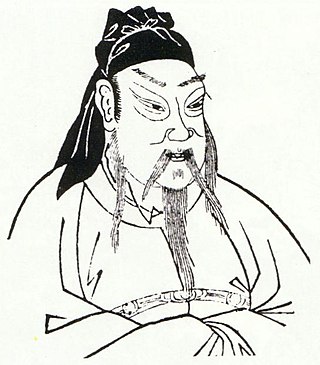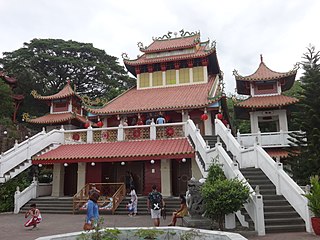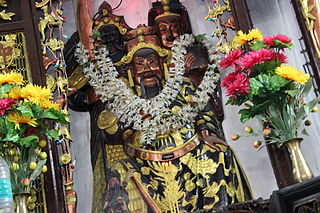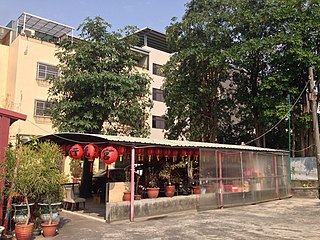
Guan Yu, courtesy name Yunchang, was a Chinese military general serving under the warlord Liu Bei during the late Eastern Han dynasty of China. Along with Zhang Fei, he shared a brotherly relationship with Liu Bei and accompanied him on most of his early exploits. Guan Yu played a significant role in the events leading up to the end of the Han dynasty and the establishment of Liu Bei's state of Shu Han during the Three Kingdoms period. While he is remembered for his loyalty towards Liu Bei, he is also known for repaying Cao Cao's kindness by slaying Yan Liang, a general under Cao Cao's rival Yuan Shao, at the Battle of Boma. After Liu Bei gained control of Yi Province in 214, Guan Yu remained in Jing Province to govern and defend the area for about seven years. In 219, while he was away fighting Cao Cao's forces at the Battle of Fancheng, Liu Bei's ally Sun Quan broke the Sun–Liu alliance and sent his general Lü Meng to conquer Liu Bei's territories in Jing Province. By the time Guan Yu found out about the loss of Jing Province after his defeat at Fancheng, it was too late. He was subsequently captured in an ambush by Sun Quan's forces and executed.
Hong Kong counts approximately 600 temples, shrines and monasteries. While Buddhism and Christianity are the most widely practiced religions, most religions are represented in the Special Administrative Region.

Dongmyo is a shrine in metropolitan Seoul, South Korea. It was built in honour of the 3rd century Chinese military commander, Guan Yu.

Chinese folk religion, also known as Chinese popular religion, comprehends a range of traditional religious practices of Han Chinese, including the Chinese diaspora. Vivienne Wee described it as "an empty bowl, which can variously be filled with the contents of institutionalised religions such as Buddhism, Taoism, Confucianism and Chinese syncretic religions”. This includes the veneration of shen (spirits) and ancestors, exorcism of demonic forces, and a belief in the rational order of nature, balance in the universe and reality that can be influenced by human beings and their rulers, as well as spirits and deities. Worship is devoted to deities and immortals, who can be deities of places or natural phenomena, of human behaviour, or founders of family lineages. Stories of these gods are collected into the body of Chinese mythology. By the Song dynasty (960-1279), these practices had been blended with Buddhist doctrines and Taoist teachings to form the popular religious system which has lasted in many ways until the present day. The present day government of mainland China, like the imperial dynasties, tolerates popular religious organizations if they bolster social stability but suppresses or persecutes those that they fear would undermine it.

Thian Hock Keng, is a temple built for the worship of Mazu, a Chinese sea goddess, located in Singapore. It is the oldest and most important temple of the Hokkien (Hoklo) people in the country. Another shrine at the back is Buddhist dedicated to Guanyin, the Mahayana Buddhist bodhisattva of mercy.

Lotus Pond is an artificial lake and popular tourist destination on the east side of Zuoying District in Kaohsiung, Taiwan. Opened in 1951, it is famous for the lotus plants on the lake and the numerous temples around the lake, including the Spring and Autumn Pavilions (春秋閣), the Dragon and Tiger Pagodas (龍虎塔), and the Confucian Temple (孔廟).

The Tou Mu Kung Temple (斗母宮) is a Taoist temple situated on Upper Serangoon Road, Singapore. Worshipping the Empress Registrar of Birth or Doumu (斗母) and Nine Emperor Gods (九皇大帝), the temple has both Taoist and Buddhist influences.

Xuanwu or Xuandi, also known as Zhenwu or Zhenwudadi, is a revered deity in Chinese religion, one of the higher-ranking deities in Taoism. He is revered as a powerful god, able to control the elements and capable of great magic. He is identified as the god of the north Heidi (黑帝, lit. 'Black Emperor' and is particularly revered by martial artists. He is the patron god of Hebei, Henan, Manchuria and Mongolia. As some Han Chinese migrated into the south from Hebei and Henan during the Tang-Song era, Xuanwu is also widely revered in the Guangdong, Guangxi and Fujian provinces, as well as among the overseas diaspora.

The Goddess of Mercy Temple, also known as Kuan Im Teng or Kong Hock Keong, is a Mahayana Buddhist temple within George Town in the Malaysian state of Penang. Located at Pitt Street, it was built in 1728, making it the oldest Buddhist temple in the state.
Landlord deities (地主神) are a type of tutelary deity worshipped in the East Asian cultural sphere. Di is the first character.

Chinese temple architecture refer to a type of structures used as place of worship of Chinese Buddhism, Taoism or Chinese folk religion, where people revere ethnic Chinese gods and ancestors. They can be classified as:

The Ma-Cho, Mazu or Ma Cho Temple is a Taoist temple to the Chinese Sea-Goddess Mazu located on Quezon Avenue in Barangay II, San Fernando, La Union in the Philippines. It was built in 1977 by a group of Filipino-Chinese devotees under the leadership of Dy Keh Hio and with the support of former Tourism Secretary Jose D. Aspiras.

Chi Ming Palace is a temple located on Lotus Lake in Zuoying District, Kaohsiung, Taiwan.

Chinese temples are associations (會館) and sites of worship of Chinese folk religion and Chinese Buddhism for the Chinese community in Kolkata. Kolkata has a significant population of Indian nationals of Chinese ethnic origin. Unofficial estimates puts the population of Indian nationals of Chinese-origin in Kolkata anywhere from 5,000 to 200,000, most of whom live in or near Tangra. The Chinese brought with them their culture. At least eight of the Chinese temples are located in the old Chinatown around Tiretta Bazar in Central Kolkata.
Enzhugong is a honorary title for certain Chinese deities worshipped by Chinese folk religion devotees and Taoists in Taiwan, especially within the Fuji Traditions. It is mainly dedicated for Lord Guan or Guansheng Dijun (關聖帝君), but also dedicated for several other deities like Chunyang Zushi (純陽祖師) or Siming Zhenjun (司命真君). Most Enzhugong's temples are usually dedicated to three or five deities, however there are also temples dedicated to more deities including Lord Guan.

State Temple of the Martial God, also called Tainan Sacrificial Rites Martial Temple or Grand Guandi Temple, is a temple located in Yongfu Road, West Central District, Tainan, Taiwan. This temple was previously the palace of Koxinga and Prince of Ningjing, members of the Ming imperial family who retreated to Taiwan in the dying days of the Ming dynasty.

Sanggar Agung Temple or Hong San Tang is a Chinese temple in Surabaya dedicated to Chinese deities and other Asian religious icons. It is located within the Pantai Ria amusement park and has become a tourist destination, even though it is originally a worship place for Tridharma followers. The name of Sanggar Agung is derived from Indonesian language which can be translated as Great Hall.

Nuo folk religion, or extendedly, Chinese popular exorcistic religion, is a variant of Chinese folk religion with its own system of temples, rituals, orders of priests, and gods that is interethnic and practiced across central and southern China but is also intimately connected to the Tujia people. It arose as an exorcistic religious movement, which is the original meaning of nuó. It has strong influences from Taoism.

Chinese folk religion plays a dynamic role in the lives of the overseas Chinese who have settled in the countries of this geographic region, particularly Burmese Chinese, Singaporean Chinese, Malaysian Chinese, Thai Chinese and Hoa. The Indonesian Chinese, by contrast, were forced to adopt en masse either Buddhism or Christianity in the 1950s and 1960s, abandoning traditional worship, due to Indonesia's religious policies which at the time forbade Chinese traditional religion or did not recognize it as a "religion" thus making it vulnerable to discrimination. Some Chinese Filipinos also still practice some Chinese traditional religions, besides Christianity of either Roman Catholicism or Protestantism, of which some have also varyingly syncretized traditional Chinese religious practices with. Chinese folk religion, the ethnic religion of Han Chinese, "Shenism" was especially coined referring to its Southeast Asian expression; another Southeast Asian name for the religion is the Sanskrit expression Satya Dharma.

In Taiwanese folk religion, yin miao are temples dedicated to wandering and homeless spirits, as opposed to yang miao, which are dedicated to deities. According to local beliefs, ghosts without a permanent resting place wandering in the human realm and may cause trouble for the living. Therefore, yin miao serve as such resting places for these spirits as a form of respect and to maintain peace. Temples dedicated to deities associated with afterlife, like Cheng Huang Ye or Di Zang Wang, are not considered yin miao.























